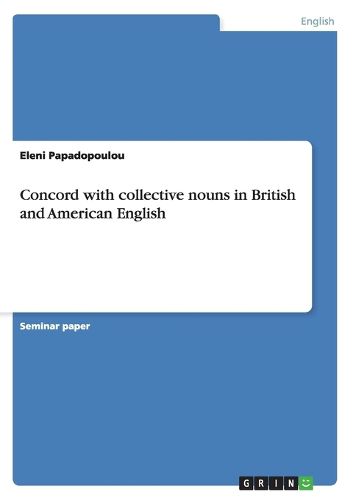Readings Newsletter
Become a Readings Member to make your shopping experience even easier.
Sign in or sign up for free!
You’re not far away from qualifying for FREE standard shipping within Australia
You’ve qualified for FREE standard shipping within Australia
The cart is loading…






Seminar paper from the year 2004 in the subject English Language and Literature Studies - Linguistics, grade: 1-, University of Sheffield, course: An Introduction to Corpus Linguistics , 5 entries in the bibliography, language: English, abstract: 1. Introduction The main and most important part of this term paper is based upon a personal corpus- based study, which should from the start be clearly characterized as relatively restrictive and not quite large in size, in order to avoid any further problems and misunderstandings. This study I mentioned above concerns and tries to closely examine the phenomenon of collective nouns, and to be more specific, we will try to examine the concord with collective nouns in both British and American English of the 1990’s, always with the hidden desire to finally come with a reasonable conclusion towards the end of the paper. In order to succeed in this procedure we will first try to give some short definitions of the most basic notions, which are used in the following pages. Then, we will proceed in describing the corpora, as well as the methodology used. Moreover, we will point out the problems that automatically arise from the fact of defining the collective nouns themselves on the one hand and of this corpus- based study as a whole on the other hand. After making these essential things clear, we will become more familiar with the theories regarding this subject; theories and theses that already exist, they have already been uttered and can be found in various books of grammar of the English language. Later on we will reveal and present the overall frequencies that derived from studying the corpora representing British and American English always in terms of concord with collective nouns. These frequencies will consist the exact findings of the study, regarding the percentages of collective nouns, which can be treated either as singulars or plurals. In addition, exploiting those findings a comparison should be made amongst the
$9.00 standard shipping within Australia
FREE standard shipping within Australia for orders over $100.00
Express & International shipping calculated at checkout
Seminar paper from the year 2004 in the subject English Language and Literature Studies - Linguistics, grade: 1-, University of Sheffield, course: An Introduction to Corpus Linguistics , 5 entries in the bibliography, language: English, abstract: 1. Introduction The main and most important part of this term paper is based upon a personal corpus- based study, which should from the start be clearly characterized as relatively restrictive and not quite large in size, in order to avoid any further problems and misunderstandings. This study I mentioned above concerns and tries to closely examine the phenomenon of collective nouns, and to be more specific, we will try to examine the concord with collective nouns in both British and American English of the 1990’s, always with the hidden desire to finally come with a reasonable conclusion towards the end of the paper. In order to succeed in this procedure we will first try to give some short definitions of the most basic notions, which are used in the following pages. Then, we will proceed in describing the corpora, as well as the methodology used. Moreover, we will point out the problems that automatically arise from the fact of defining the collective nouns themselves on the one hand and of this corpus- based study as a whole on the other hand. After making these essential things clear, we will become more familiar with the theories regarding this subject; theories and theses that already exist, they have already been uttered and can be found in various books of grammar of the English language. Later on we will reveal and present the overall frequencies that derived from studying the corpora representing British and American English always in terms of concord with collective nouns. These frequencies will consist the exact findings of the study, regarding the percentages of collective nouns, which can be treated either as singulars or plurals. In addition, exploiting those findings a comparison should be made amongst the